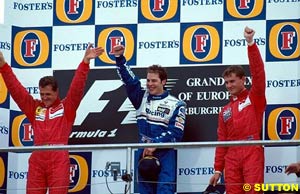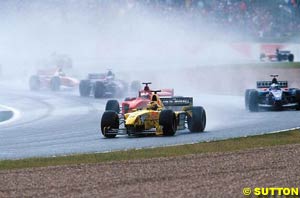
Atlas F1 Magazine Writer
With half of the season gone, how do the drivers and teams compare to their performance in the first half of 2002? Which drivers are on the up, and who is on the way down? What record - yes, another - Michael Schumacher can break this weekend? And which French Grand Prix is without a doubt the most exciting to take place at Magny Cours? Marcel Schot brings the answers and more anecdotes on the ninth and tenth rounds of 2003
The effect of the new points system is remarkable. Steady finisher Ralf Schumacher - the only driver to finish all races in the points so far - is well rewarded. The German ranks fourth with the new system, whereas he would only have been sixth with the old system. His teammate, Juan Pablo Montoya, suffers from the opposite effect. He ranks fifth according to the new system, while the old system would have seen him in third.
When comparing the 2003 standings as calculated by the 2002 system to the 2002 points after eight races, young guns Kimi Raikkonen and Fernando Alonso are the big risers. Despite leading the Championship, Michael Schumacher is the biggest dropper by far. The World Champion had a worse first half of the season than his near perfect opening last season. Further big droppers are Ralf Schumacher and David Coulthard, who are both nine points down on last year's mark. Jenson Button and Nick Heidfeld are also nowhere near their last year's performance.
When we look at the teams, McLaren and Renault make up for what Ferrari and Williams lose, deeming the Constructors' Championship an interesting one so far. Among the lower ranked teams, Sauber is the big disappointment. Jordan and BAR both score better than in last year's first half, but for Jordan that's because of a single result - their win at the Brazilian Grand Prix.
In recent years, the Nurburgring has often showcased battles between Schumacher and McLaren rival David Coulthard. The two first met there in 1995, when the 'Ring made its return after a nine year abscence. While Coulthard took pole in his Williams, Schumacher went home with the victory in the Benetton ahead of Ferrari driver Jean Alesi and David Coulthard.
In 1996 both drivers had switched teams. Schumacher had gone to the struggling Ferrari team and Coulthard had switched to McLaren. The Ferrari driver impressed with second place, closely behind Williams rookie Jacques Villeneuve, who took his first victory. David Coulthard scored his second third place in a row, albeit over 30 seconds behind the first two drivers.
The next year the European Grand Prix moved to Jerez and the Nurburgring was on the calendar as the Luxembourg Grand Prix. This time both Schumacher and Coulthard retired. The second and last Luxembourg Grand Prix, in 1998, was better for the two rivals. While the win went to Coulthard's teammate Mika Hakkinen, Schumacher scored a second place and Coulthard added yet another third. In 1999 Schumacher wasn't there, having broken his leg at Silverstone, and Coulthard didn't finish the race, after he slid off and into the barriers.
The 2000 race saw a repeat of the 1995 results: Coulthard grabbed pole and Schumacher won. For the fourth time, David Coulthard finished in third place, this time with Mika Hakkinen between himself and winner Schumacher. The next race at the Eiffel circuit saw Schumacher more dominant than before, scoring pole and victory. For Coulthard, it was the fifth third place in seven races at the track. New Williams driver Juan Pablo Montoya completed the podium.
That same Montoya was responsible for David Coulthard's exit last year. When the faster McLaren driver attempted to overtake the Colombian, Montoya lost the back end and hit Coulthard in the side. Schumacher finished second behind his teammate Rubens Barrichello, who lead from start to finish.
The fact that both events happened on French soil is really one of the few similarities between present day French Grands Prix and those almost 100 years ago. The first event in 1906 was driven over two days of six laps of 103.180 km each. The circuit was the triangle Champagne, La Ferte Bernard, St. Calais, east of Le Mans. The winner was Ferenc Szisz in a Renault, who completed the distance in 12 hours, 14 minutes and seven seconds, averaging 101.195 km/h. Compare that with today's 300 km and two hour limit! Szisz's lead was also something you can't compare to these days; Fiat driver Felice Nazzaro came home second, over 32 minutes behind the winner.
Looking at the more recent history, we see Michael Schumacher once again dominating the statistics. Since the French Grand Prix moved to Magny Cours in 1991, Schumacher has won six times (1994, 1995, 1997, 1998, 2001, 2002). Nigel Mansell has been the only other driver to have won twice at Magny Cours.
However, the most remarkable victory at Magny Cours didn't come from Schumacher or Mansell. The 1999 race already started out with a wet qualifying that saw the entire field mixed up with the unlikely front row of Rubens Barrichello (Stewart) and Jean Alesi (Sauber). On Sunday the race started in overcast weather conditions and Barrichello kept the lead nicely, with David Coulthard quickly tucked in under his rearwing. A few laps later the McLaren driver made his way past the Stewart, only to retire a couple of laps later.
And then the skies opened and a curtain of water fell upon the earth. Every driver came in as soon as possible, but even on full wets several drivers spun off before the safety car was issued. It wasn't imminent right then, but the Jordan team made a brilliant move by filling up the cars and changing to a one stop strategy. This didn't work out for Damon Hill, as the veteran collided with an Arrows in the pits and had to come in again the next lap with a pucture. However, for Heinz Harald Frentzen it paid off in full.
After ten laps the safety car came back in and racing resumed. Even though Barrichello took the lead and Mika Hakkinen took second in the McLaren, both had to come in for a second stop and Frentzen cruised to his second victory in what's without a shadow of a doubt the most exciting race to have been held at Magny Cours.
With half the season gone, it's time to have a look at the progress the teams and drivers have made since last season.
Points 2003 Points 2003 Points 2002 Change
Driver 2003 system 2002 system
M.Schumacher 54 48 70 -22
Raikkonen 51 39 7 +32
Alonso 34 20 - +20
R.Schumacher 33 18 27 - 9
Montoya 31 23 27 - 4
Barrichello 31 20 16 + 4
Coulthard 25 17 26 - 9
Trulli 13 5 4 + 1
Fisichella 10 10 6 + 4
Button 8 3 8 - 5
Frentzen 7 3 2 + 1
Webber 6 0 2 - 2
Villeneuve 3 1 0 + 1
da Matta 3 1 - + 1
Heidfeld 1 0 5 - 5
Firman 1 0 - 0
Panis 1 0 0 0
Verstappen 0 0 - 0
Wilson 0 0 - 0
Pizzonia 0 0 - 0
Points 2003 Points 2003 Points 2002 Change
Team 2003 system 2002 system
Ferrari 85 68 86 -18
McLaren 76 56 33 +23
Williams 64 41 54 -13
Renault 47 25 12 +13
Jordan 11 10 6 + 4
BAR 11 4 0 + 4
Sauber 8 3 8 - 5
Jaguar 6 0 3 - 3
Toyota 4 1 2 - 1
Minardi 0 0 2 - 2
 Michael Schumacher can break another record after the European Grand Prix at the Nurburgring. A win would give the German his fourth at the Eiffel track, leaving Juan Manuel Fangio and Jackie Stewart behind him. However, both Ringmasters won their races on the old circuit, whereas Schumacher won them all on the new circuit.
Michael Schumacher can break another record after the European Grand Prix at the Nurburgring. A win would give the German his fourth at the Eiffel track, leaving Juan Manuel Fangio and Jackie Stewart behind him. However, both Ringmasters won their races on the old circuit, whereas Schumacher won them all on the new circuit.
 Something the new Nurburgring and Magny Cours, where the next race is held, have in common is that they're both regarded as modern, soulless tracks as replacement for tracks where legendary races were hosted in the past. Whereas the Nurburgring is a small part of the circuit of all circuits, Magny Cours is simply the latest location of a French Grand Prix that has traveled throughout France in its 88 editions.
Something the new Nurburgring and Magny Cours, where the next race is held, have in common is that they're both regarded as modern, soulless tracks as replacement for tracks where legendary races were hosted in the past. Whereas the Nurburgring is a small part of the circuit of all circuits, Magny Cours is simply the latest location of a French Grand Prix that has traveled throughout France in its 88 editions.
|
Volume 9, Issue 26
Atlas F1 Exclusive
Interview with Allan McNish
Giancarlo Fisichella: Through the Visor
Atlas F1 Special
Tifoso IPO
Articles
Season in the Sun: Part V
European GP Preview
European GP Preview
Europe and France Facts & Stats
Columns
The F1 Trivia Quiz
Bookworm Critique
On the Road
Elsewhere in Racing
The Weekly Grapevine
> Homepage |